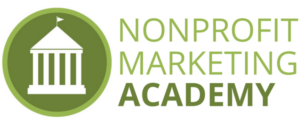
The mission-focused content model expands and deepens storytelling.
Nonprofits rely heavily on storytelling for business success.
We share our stories with board members so they, in turn, can share our important work with their networks.
Our stories about our programs and initiatives help prove the outcomes of our efforts to the media, donors, and funders.
Stories about our employees help job candidates know what it is like to be a part of the team.
At every opportunity, we are sharing stories about our work and the nonprofit’s mission.
It’s no wonder that with all the storytelling we should be doing, we can sometimes feel the content well has run dry. We may even find ourselves in a creative slump and looking for something new to share.
If a nonprofit is not yet fully established, storytelling can be especially daunting.
New nonprofit leaders face tough challenges that prompt concerns like: How do I share our story? What marketing channels do I use? How can I make our storytelling as interesting as the work we are doing?
How formal does our marketing need to be? Are people reading our stories? How can I get people to share our stories?
Believe it or not, there IS a ‘secret sauce’ or ‘special formula’ that nonprofits can follow to gain the highest return on content marketing and specifically storytelling.
The secret is to use the mission-focused content model of storytelling.
In simple terms, mission-focused content exploits every opportunity within a nonprofit to create a story. The model goes beyond the traditional stories that are told, such as stories about volunteers, donors, and clients. It takes a deeper look into the organization and involves looking at how each employee individually contributes to the work of the nonprofit, how employees contribute to the community in ways outside of the nonprofit, how vendors contribute to the nonprofit’s mission, how and why the nonprofit programs are developed, managed and evaluated, how money is raised, managed and spent, and much, much more.
When nonprofits implement a mission-focused model to storytelling, the content achieves three core relationship-building outcomes.
- Transparency – With mission-focused content, the nonprofit’s audiences learn more about the operations and the people within a nonprofit because the stories about funding, people, and programs create transparency.
- Trust – The deeper storytelling leads to stronger trust between the nonprofit and its many investors.
- Improved Fundraising – Broad storytelling not only reveals the outcomes of the nonprofit’s programs but also information about the processes used and the people and partnerships involved. This level of storytelling gives supporters a deeper understanding of the nonprofit’s efforts to carry out its mission and more of a reason to donate.
What kind of storytelling content should nonprofits create?
Storytelling inspires and sticks with an audience like no other form of content. Tie storytelling to every layer of the nonprofit’s mission, and you have an overflowing content well. When nonprofits use the deep journey of mission-focused content, the audience is engaged for a longer period of time and at a deeper level. Below is one example of mission-focused storytelling.
EXAMPLE PROJECT: Nonprofit Plans to Launch a New Reading Program
- A video featuring the executive director tells why the program is so important; it introduces the team members who will be developing the program.
- Weekly blog and social media updates from team members document the work in progress and take the audience behind the scenes.
- Social media content featuring the students who will benefit from the program adds faces and personalities for the audience to connect with.
- A project landing page features content in a variety of forms such as a project timeline or countdown mechanism.
- Monthly updates on the fundraising progress and how the money is allocated are used to build trust with the audience and results in a higher ROI on content calls-to-action.
- A monthly podcast, hosted by the nonprofit leadership, interviews sponsors and other business partners to create awareness about the community’s involvement in the project.

Example of mission-focused content sharing about the Reading Project progress.
Free tools for mission-focused content storytelling.
- Canva – Canva is a free graphic design software with thousands of templates and design ideas that help turn stories into real life visual content.
- Pixabay – Pixabay is a repository of royalty-free images and videos. When privacy is a concern for a nonprofit, use Pixabay images and videos to tell the story.
- Bensound – Music can evoke deep emotions. Add music to your stories with royalty-free music from sites like Bensound Music.
- YouTube Sound Effects – What makes a story more real than sound effects? Download free sound effects for your next project.
- Screencast-o-matic – Record video content with something as simple as a smartphone, and bring it all together into one powerful video with special effects. Screencast-o-matic offers a free version with a video watermark and also a very low-cost paid subscription level ($1.50/month – yep, one dollar and fifty cents).
Find more free and low-cost resources in the Nonprofit Marketing Academy resource center.
Step-by-Step tutorials for creating mission-focused content.
Now that you have the tools above to create the content, clear your mind and turn to the easy-to-follow video tutorials below to learn specifically what content to create.




